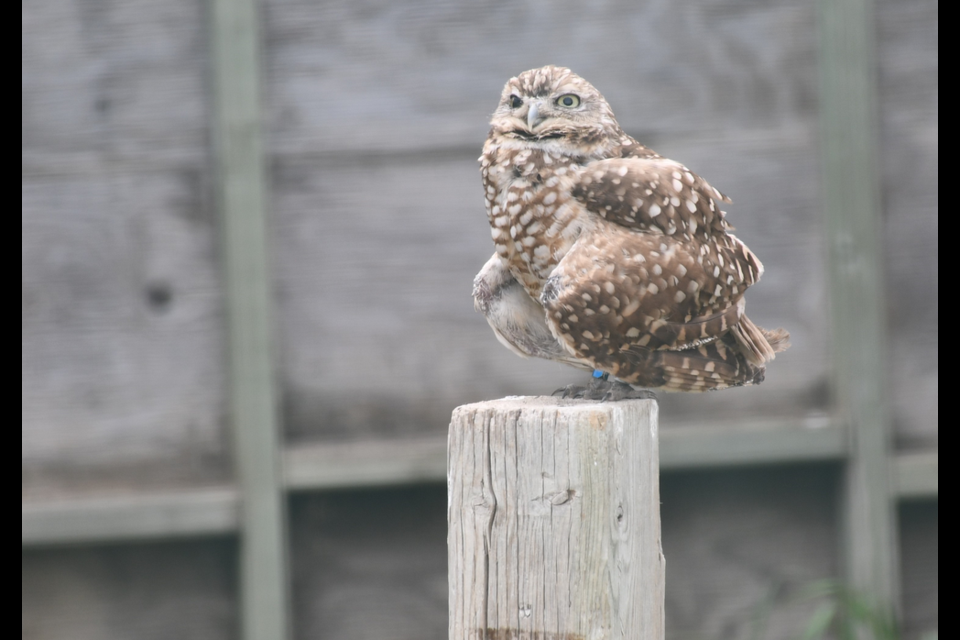Although there have been no hard studies on the actual numbers of burrowing owls in the wild, the one thing known for sure is that there are 10 of the endangered species who make their home at the Saskatchewan Burrowing Owl Interpretive Centre (SBOIC), located on the Moose Jaw Exhibition Association Thatcher Street East grounds, and this year there will be no population increase from the local captive breeding program.
It is not for a lack of trying, but rather the nine eggs laid this year simply did not hatch.
The most likely reason is the eggs were not fertilized but the exact reason is unknown.
“We think the reason is because of the weather or they were just not fertile,” Lori Johnson coordinator of the SBOIC told MJ Independent. “It is hard to say.”
Asked if the nine eggs laid not hatching may have been caused by the adjacent re-development of formerly leased Exhibition Company lands by Canadian Tire, Johnson said she could not see that playing any part of it.
“No I don’t think that played a factor in it all. It could have been something like the wet weather we experienced in a major rainfall that caused it,” she said.
Johnson pointed to the fact the birds at the SBOIC are used to human activity and have successfully produced birds in the past as a way to rule out the Canadian Tire re-development as a source of the lack of babies this year.
It also needs to be noted that on their own initiative Canadian Tire made enquiries if their re-development might play a factor in the owl’s successfully hatching this year’s broods. If the answer was yes, the Canadian retail giant was prepared to delay work to help protect the owls.
“It all depends on the individual bird (if outside activity will disturb them in hatching eggs). Those owls of ours are in captivity and have laid before in captivity, so a little bit of disturbance does not bother them.”
Age likely made a difference in the viability of some of the eggs as the birds are getting older.
“We weren’t expecting the clutch of eggs from our little bonded pair to hatch as they are on the older side,” Johnson said.
The life-span of burrowing owls is eight — 10 years in captivity and three to six years in the wild.
The female bird in the bonded pair is now eight years old and reaching the end of her ability to produce offspring.
“We weren’t expecting one pair to lay eggs when they did lay (eggs) it would have been good to have some babies. The last successful breeding was in 2019 when Elly and Lily were hatched,” Johnson said.
The two females are now part of the Moose Jaw breeding program.
The owls start laying eggs near the end of May.
In 2019 the SBOIC had three owls hatch but one sadly died at a young age.
Losing owls after they hatch is not uncommon Johnson said but “their hatch rate as a rule is pretty good.”
In the wild, the burrowing owls lose more young than their captive relatives.
“In the wild many more young die. The main reasons are predation and inadequate food sources to feed and maintain the young.”
Despite the disappointing year, the SBOIC is hoping to acquire two additional owls from the breeding program in Manitoba to help build up the breeding program in Moose Jaw.
“We are in the process of getting a permit so we can bring in a couple of males for the (Moose Jaw breeding program) from Manitoba.”
This year the breeding and release program in Manitoba has successfully hatched 28 owls. Other programs in Canada breeding and releasing owls back into the wild are the Calgary Zoo and the Head Start program in British Columbia.
Moose Jaw, at the present time, is a captive breeding program only and they are not at this time re-introducing owls into the wild.
Despite the second year in a row — the quiet year of 2020, the Year of the Pandemic — without producing offspring, Johnson said the program does help support burrowing owls out in the wild by reminding many local people and governments that the owls are in the area, they are important and need to be protected.
“It is very important we concentrate on the education portion of the program. People aren’t going to say and talk about something like the owls when they do not know about them.”
The SBOIC is open to the public and in a 'normal,' non COVID-19 pandemic year has about 3,000 to 5,000 visitors stop in and visit, making it not only a place to talk about the owls but also a major tourist draw to the city.
In their outreach program the SBOIC speaks to various groups and brings the owls and their plight to about 2,000 to 3,000 people on an annual basis.
“The outreach program does benefit the community…it allows people to know we have an endangered animal in the area and how they can help the owls out.”
https://www.mjindependent.com/new-blog/2021/7/29/all-burrowing-owl-eggs-fail-to-hatch




